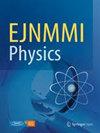Clinical application of a population-based input function (PBIF) for a shortened dynamic whole-body FDG-PET/CT protocol in patients with metastatic melanoma treated by immunotherapy
IF 3
2区 医学
Q2 RADIOLOGY, NUCLEAR MEDICINE & MEDICAL IMAGING
引用次数: 0
Abstract
The aim was to investigate the feasibility of a shortened dynamic whole-body (dWB) FDG-PET/CT protocol and Patlak imaging using a population-based input function (PBIF), instead of an image-derived input function (IDIF) across the 60-min post-injection period, and study its effect on the FDG influx rate (Ki) quantification in patients with metastatic melanoma (MM) undergoing immunotherapy. Thirty-seven patients were enrolled, including a PBIF modeling group (n = 17) and an independent validation cohort (n = 20) of MM from the ongoing prospective IMMUNOPET2 trial. All dWB-PET data were acquired on Vision 600 PET/CT systems. The PBIF was fitted using a Feng’s 4-compartments model and scaled to the individual IDIF tail’s section within the shortened acquisition time. The area under the curve (AUC) of PBIFs was compared to respective IDIFs AUC within 9 shortened time windows (TW) in terms of linear correlation (R2) and Bland–Altman tests. Ki metrics calculated with PBIF vs IDIF on 8 organs with physiological tracer uptake, 44 tumoral lesions of MM and 11 immune-induced inflammatory sites of pseudo-progression disease were also compared (Mann–Whitney test). The mean ± SD relative AUC bias was calculated at 0.5 ± 3.8% (R2 = 0.961, AUCPBIF = 1.007 × AUCIDIF). In terms of optimal use in routine practice and statistical results, the 5th–7th pass (R2 = 0.999 for both Ki mean and Ki max) and 5th–8th pass (mean ± SD bias = − 4.9 ± 6.5% for Ki mean and − 4.8% ± 5.6% for Ki max) windows were selected. There was no significant difference in Ki values from PBIF5_7 vs IDIF5_7 for physiological uptakes (p > 0.05) as well as for tumor lesions (mean ± SD Ki IDIF5_7 3.07 ± 3.27 vs Ki PBIF5_7 2.86 ± 2.96 100ml/ml/min, p = 0.586) and for inflammatory sites (mean ± SD Ki IDIF5_7 1.13 ± 0.59 vs Ki PBIF5_7 1.13 ± 0.55 100ml/ml/min, p = 0.98). Our study showed the feasibility of a shortened dWB-PET imaging protocol with a PBIF approach, allowing to reduce acquisition duration from 70 to 20 min with reasonable bias. These findings open perspectives for its clinical use in routine practice such as treatment response assessment in oncology.基于群体的输入函数 (PBIF) 在免疫疗法治疗的转移性黑色素瘤患者的缩短动态全身 FDG-PET/CT 方案中的临床应用
该研究旨在探讨缩短动态全身(dWB)FDG-PET/CT方案和Patlak成像的可行性,在注射后60分钟内使用基于群体的输入函数(PBIF)而不是基于图像的输入函数(IDIF),并研究其对接受免疫疗法的转移性黑色素瘤(MM)患者FDG流入率(Ki)量化的影响。该研究共招募了 37 名患者,包括一个 PBIF 模型组(n = 17)和一个来自正在进行的前瞻性 IMMUNOPET2 试验的 MM 独立验证组(n = 20)。所有 dWB-PET 数据都是在 Vision 600 PET/CT 系统上获得的。在缩短的采集时间内,PBIF 采用 Feng's 4 室模型进行拟合,并缩放至 IDIF 尾部的各个部分。通过线性相关(R2)和布兰-阿尔特曼检验,将 PBIF 的曲线下面积(AUC)与 9 个缩短时间窗(TW)内各自 IDIF 的 AUC 进行比较。此外,还比较了 PBIF 与 IDIF 对 8 个具有生理性示踪剂摄取的器官、44 个 MM 肿瘤病灶和 11 个免疫诱导的假性疾病炎症部位计算的 Ki 指标(曼-惠特尼检验)。计算得出的平均值(± SD)相对 AUC 偏差为 0.5 ± 3.8%(R2 = 0.961,AUCPBIF = 1.007 × AUCIDIF)。根据常规实践和统计结果的最佳使用情况,选择了第 5-7 次(Ki 平均值和 Ki 最大值的 R2 = 0.999)和第 5-8 次(Ki 平均值的平均 ± SD 偏差 = - 4.9 ± 6.5%,Ki 最大值的平均 ± SD 偏差 = - 4.8% ± 5.6%)窗口。PBIF5_7 与 IDIF5_7 的 Ki 值在生理摄取(p > 0.05)和肿瘤病变(平均 ± SD Ki IDIF5_7 3.07 ± 3.27 vs Ki PBIF5_7 2.86 ± 2.96 100ml/ml/min,p = 0.586)和炎症部位(平均 ± SD Ki IDIF5_7 1.13 ± 0.59 vs Ki PBIF5_7 1.13 ± 0.55 100ml/ml/min,p = 0.98)。我们的研究表明,采用 PBIF 方法缩短 dWB-PET 成像方案是可行的,可将采集时间从 70 分钟缩短到 20 分钟,且偏差合理。这些发现为其在肿瘤治疗反应评估等常规临床实践中的应用开辟了前景。
本文章由计算机程序翻译,如有差异,请以英文原文为准。
求助全文
约1分钟内获得全文
求助全文
来源期刊

EJNMMI Physics
Physics and Astronomy-Radiation
CiteScore
6.70
自引率
10.00%
发文量
78
审稿时长
13 weeks
期刊介绍:
EJNMMI Physics is an international platform for scientists, users and adopters of nuclear medicine with a particular interest in physics matters. As a companion journal to the European Journal of Nuclear Medicine and Molecular Imaging, this journal has a multi-disciplinary approach and welcomes original materials and studies with a focus on applied physics and mathematics as well as imaging systems engineering and prototyping in nuclear medicine. This includes physics-driven approaches or algorithms supported by physics that foster early clinical adoption of nuclear medicine imaging and therapy.
 求助内容:
求助内容: 应助结果提醒方式:
应助结果提醒方式:


